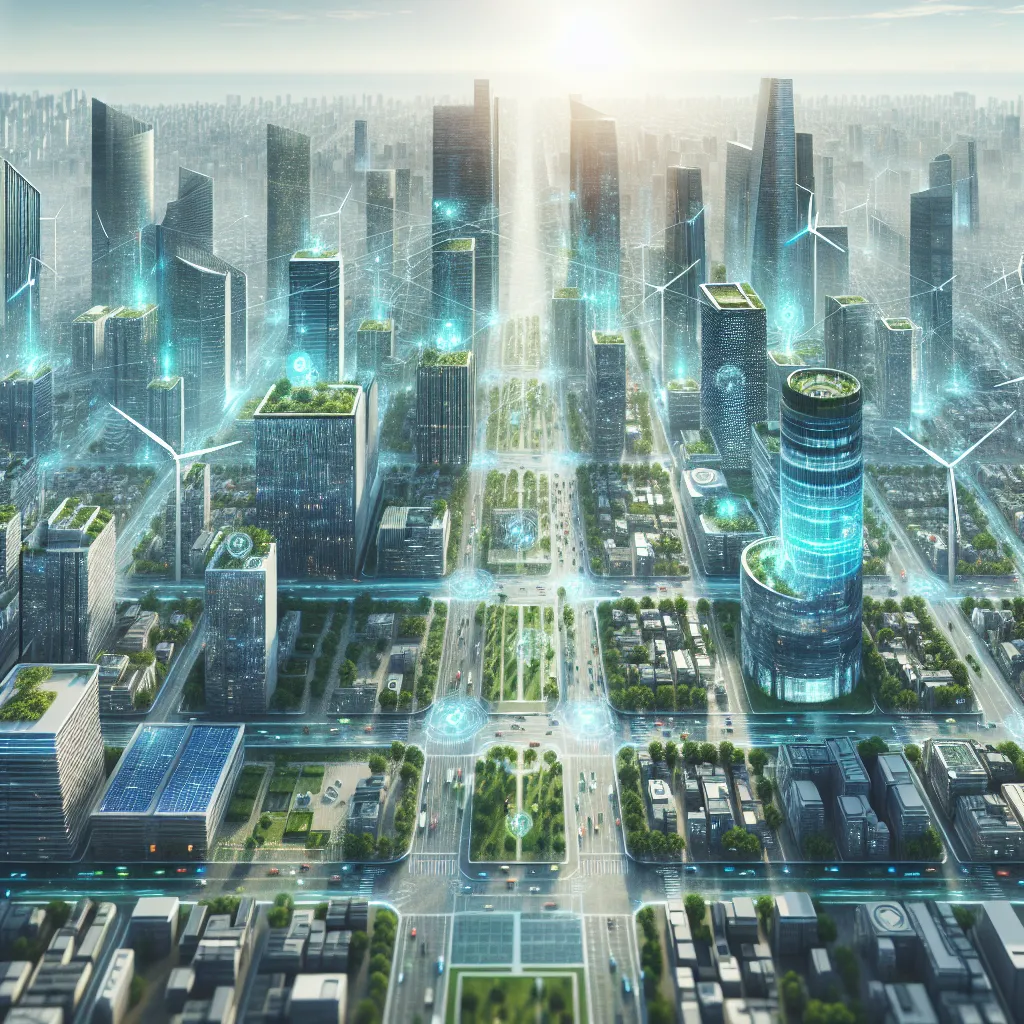Welcome to our IELTS Reading practice test focused on “The Future of Smart Cities and Urban Development.” This comprehensive test will help you prepare for the IELTS Reading section by providing realistic passages and questions that mirror the actual exam. Let’s dive into the world of urban innovation and explore how technology is shaping our cities of tomorrow.
Table Of Contents
- Passage 1 – Easy Text
- The Rise of Smart Cities
- Questions 1-7
- Questions 8-13
- Passage 2 – Medium Text
- The Challenges and Opportunities of Smart City Implementation
- Questions 14-19
- Questions 20-26
- Passage 3 – Hard Text
- The Socioeconomic Implications of Smart City Development
- Questions 27-32
- Questions 33-40
- Answer Key
- Passage 1
- Passage 2
- Passage 3
 Aerial view of a futuristic smart city
Aerial view of a futuristic smart city
Passage 1 – Easy Text
The Rise of Smart Cities
Smart cities are rapidly emerging as the future of urban development, leveraging technology to enhance the quality of life for residents and improve the efficiency of city operations. These innovative urban centers utilize data analytics, Internet of Things (IoT) devices, and artificial intelligence to address various challenges faced by modern cities.
One of the primary goals of smart cities is to optimize resource management. By implementing smart grids and intelligent energy systems, cities can reduce energy consumption and minimize their carbon footprint. For example, smart streetlights adjust their brightness based on ambient light conditions and pedestrian activity, saving energy and reducing light pollution.
Transportation is another key area where smart cities excel. Intelligent traffic management systems use real-time data to reduce congestion and improve traffic flow. Additionally, the integration of autonomous vehicles and shared mobility services promises to revolutionize urban transportation, making it more efficient and environmentally friendly.
Smart cities also prioritize sustainability and environmental protection. Green building technologies, such as energy-efficient facades and rainwater harvesting systems, are becoming increasingly common. Furthermore, urban farming initiatives and smart waste management solutions contribute to a more sustainable and circular economy within cities.
The implementation of smart city technologies also has significant implications for public safety and healthcare. Advanced surveillance systems and predictive policing tools help law enforcement agencies prevent crime and respond more effectively to emergencies. In the healthcare sector, telemedicine and remote patient monitoring improve access to medical services and reduce the burden on hospitals.
As cities continue to grow and evolve, the concept of smart cities offers a promising solution to the challenges of urbanization. By harnessing the power of technology and data, these innovative urban centers are paving the way for a more sustainable, efficient, and livable future.
Questions 1-7
Do the following statements agree with the information given in the reading passage?
Write:
TRUE if the statement agrees with the information
FALSE if the statement contradicts the information
NOT GIVEN if there is no information on this
- Smart cities use technology to improve the quality of life for residents.
- Smart grids are used to increase energy consumption in cities.
- Intelligent traffic management systems use historical data to improve traffic flow.
- Autonomous vehicles are already widely used in smart cities.
- Green building technologies are becoming more popular in smart cities.
- Smart city technologies have no impact on public safety.
- The concept of smart cities is expected to solve all urbanization problems.
Questions 8-13
Complete the sentences below.
Choose NO MORE THAN TWO WORDS from the passage for each answer.
- Smart streetlights adjust their brightness based on __ and pedestrian activity.
- The integration of autonomous vehicles and shared mobility services aims to make urban transportation more __ and environmentally friendly.
- __ and smart waste management solutions contribute to a more sustainable economy in cities.
- Advanced surveillance systems and predictive policing tools help __ prevent crime.
- In the healthcare sector, __ improves access to medical services.
- Smart cities offer a promising solution to the challenges of __.
Passage 2 – Medium Text
The Challenges and Opportunities of Smart City Implementation
While the concept of smart cities holds great promise for urban development, the implementation of these technologies presents both challenges and opportunities. As cities around the world strive to become “smarter,” they must navigate complex issues related to infrastructure, data privacy, cybersecurity, and social equity.
One of the primary challenges in developing smart cities is the substantial investment required to upgrade existing infrastructure and implement new technologies. Many cities, particularly those in developing countries, struggle to secure the necessary funding for such ambitious projects. Moreover, the rapid pace of technological advancement means that cities must continually invest in upgrading their systems to remain at the forefront of innovation.
Data privacy and security concerns are also significant hurdles in smart city development. The vast amount of data collected by IoT devices and sensors raises questions about individual privacy rights and the potential for data breaches. Cities must strike a delicate balance between leveraging data for improved services and protecting citizens’ personal information. Implementing robust cybersecurity measures is crucial to safeguarding critical infrastructure and sensitive data from malicious attacks.
Another challenge is ensuring equitable access to smart city technologies and services. There is a risk that the benefits of smart cities may disproportionately favor affluent neighborhoods, exacerbating existing social and economic inequalities. City planners and policymakers must prioritize inclusive development strategies that ensure all residents can benefit from smart city initiatives, regardless of their socioeconomic status.
Despite these challenges, the opportunities presented by smart cities are substantial. The integration of advanced technologies into urban infrastructure has the potential to dramatically improve the efficiency of city operations, reduce resource consumption, and enhance the overall quality of life for residents. For example, smart water management systems can detect leaks and optimize distribution, leading to significant water conservation. Intelligent energy grids can balance supply and demand more effectively, reducing waste and lowering costs for consumers.
Smart cities also offer opportunities for economic growth and innovation. The development and implementation of smart city technologies create new jobs and industries, fostering a culture of entrepreneurship and technological innovation. Additionally, the improved efficiency and livability of smart cities can attract businesses and talent, boosting the local economy.
Furthermore, smart cities have the potential to significantly reduce environmental impact. By optimizing energy use, promoting sustainable transportation, and implementing efficient waste management systems, smart cities can play a crucial role in combating climate change and creating more resilient urban environments.
As cities continue to grapple with the complexities of smart city implementation, it is clear that the potential benefits outweigh the challenges. With careful planning, robust security measures, and a commitment to inclusive development, smart cities can pave the way for a more sustainable, efficient, and equitable urban future.
Questions 14-19
Choose the correct letter, A, B, C, or D.
-
What is mentioned as a primary challenge in developing smart cities?
A) Lack of technological innovation
B) Resistance from residents
C) Substantial investment requirements
D) Limited urban space -
According to the passage, what is a concern related to data collection in smart cities?
A) The accuracy of collected data
B) The potential for data breaches
C) The limited use of collected data
D) The cost of data storage -
What risk is associated with the implementation of smart city technologies?
A) Increased unemployment
B) Higher crime rates
C) Exacerbation of social inequalities
D) Reduced cultural diversity -
What is mentioned as an opportunity presented by smart cities?
A) Decreased need for urban planning
B) Improved efficiency of city operations
C) Elimination of all environmental problems
D) Reduced need for human workers -
How can smart cities contribute to economic growth?
A) By increasing government subsidies
B) By eliminating all traditional industries
C) By creating new jobs and industries
D) By reducing the population of cities -
What role can smart cities play in environmental conservation?
A) Eliminating all forms of pollution
B) Reducing environmental impact through optimized resource use
C) Completely replacing fossil fuels with renewable energy
D) Stopping urban development to preserve natural areas
Questions 20-26
Complete the summary below.
Choose NO MORE THAN TWO WORDS from the passage for each answer.
Smart cities face several challenges in their implementation, including the need for 20 __ to upgrade infrastructure and the 21 __ of technological advancement. Concerns about 22 __ and the potential for data breaches must be addressed through robust cybersecurity measures. Ensuring 23 __ to smart city technologies is crucial to prevent exacerbating social inequalities.
Despite these challenges, smart cities offer significant opportunities. The integration of advanced technologies can improve 24 __ and reduce resource consumption. Smart cities also create opportunities for 25 __ and innovation, attracting businesses and talent. Furthermore, they have the potential to 26 __ by optimizing energy use and promoting sustainable practices.
Passage 3 – Hard Text
The Socioeconomic Implications of Smart City Development
The advent of smart cities represents a paradigm shift in urban development, promising to revolutionize the way we live, work, and interact within urban environments. However, the implementation of smart city technologies and policies has far-reaching socioeconomic implications that extend beyond mere technological innovation. As cities worldwide embrace this new model of urban development, it is crucial to examine the complex interplay between smart city initiatives and their impact on social structures, economic systems, and human behavior.
One of the most significant socioeconomic challenges posed by smart cities is the potential exacerbation of existing inequalities. While smart city technologies have the capacity to improve overall quality of life, there is a risk of creating a digital divide between those who have access to and can benefit from these technologies and those who cannot. This divide may manifest in various forms, such as disparities in access to high-speed internet, smart devices, or the skills necessary to navigate an increasingly digital urban landscape. Consequently, policymakers and urban planners must prioritize inclusive design and implementation strategies that ensure equitable access to smart city benefits across all socioeconomic strata.
The labor market dynamics within smart cities also warrant careful consideration. The proliferation of automation and artificial intelligence in urban systems may lead to job displacement in certain sectors, particularly those involving routine or manual tasks. Conversely, the development and maintenance of smart city infrastructure are likely to create new employment opportunities in fields such as data analysis, software engineering, and urban technology management. This shift in the job market necessitates a proactive approach to workforce development and reskilling initiatives to ensure that the local population can adapt to and benefit from the changing economic landscape.
The data-driven governance model inherent to smart cities raises important questions about privacy, autonomy, and the nature of civic participation. The extensive data collection and analysis capabilities of smart city systems can lead to more efficient and responsive public services. However, they also pose risks of surveillance and control, potentially altering the relationship between citizens and government. Striking a balance between leveraging data for public good and protecting individual rights is a critical challenge that smart cities must address to maintain public trust and democratic principles.
Furthermore, the implementation of smart city technologies has the potential to significantly impact urban social dynamics. The increased connectivity and digitalization of urban spaces may transform traditional forms of community interaction and social cohesion. While digital platforms can facilitate new forms of civic engagement and community organization, there is also a risk of diminishing face-to-face interactions and exacerbating social isolation. Urban planners and policymakers must consider how to harness the connective potential of smart technologies while preserving and enhancing physical community spaces and social bonds.
The economic model underpinning smart city development also merits scrutiny. The significant investments required for smart city infrastructure often necessitate partnerships between public entities and private technology companies. This public-private collaboration can drive innovation and efficiency but also raises concerns about the corporatization of urban governance and the potential prioritization of profit over public interest. Ensuring transparency, accountability, and democratic oversight in these partnerships is crucial to maintaining the integrity of urban governance and preserving public trust.
Moreover, the environmental sustainability aspects of smart cities have profound socioeconomic implications. While smart technologies can optimize resource use and reduce environmental impact, the production and disposal of digital devices and infrastructure components pose their own environmental challenges. Balancing the potential environmental benefits of smart city systems with their lifecycle impacts requires a holistic approach to urban sustainability that considers both technological solutions and broader patterns of consumption and waste.
In conclusion, the development of smart cities represents a complex and multifaceted transformation of urban environments with far-reaching socioeconomic consequences. As cities continue to evolve in this digital age, it is imperative to approach smart city initiatives with a critical and nuanced perspective that considers their full spectrum of impacts on urban populations. By addressing issues of equity, labor market shifts, governance, social dynamics, and environmental sustainability, smart cities can strive to create truly inclusive, resilient, and sustainable urban futures that benefit all members of society.
Questions 27-32
Choose the correct letter, A, B, C, or D.
-
According to the passage, what is a major socioeconomic challenge posed by smart cities?
A) Overcrowding in urban areas
B) Potential exacerbation of existing inequalities
C) Decrease in overall quality of life
D) Lack of technological innovation -
What does the passage suggest about the impact of smart cities on the job market?
A) It will only create new jobs in the technology sector
B) It will have no effect on employment
C) It may lead to job displacement in some sectors while creating opportunities in others
D) It will eliminate all manual labor jobs -
What concern does the passage raise about data-driven governance in smart cities?
A) It may lead to more efficient public services
B) It could potentially alter the relationship between citizens and government
C) It will eliminate the need for human decision-making
D) It will solve all urban problems immediately -
How might smart city technologies impact urban social dynamics according to the passage?
A) They will only improve community interactions
B) They have no effect on social cohesion
C) They may transform traditional forms of community interaction
D) They will eliminate all forms of social isolation -
What concern is raised about public-private collaboration in smart city development?
A) It may lead to the corporatization of urban governance
B) It will eliminate all government control
C) It will result in complete transparency
D) It will solve all funding issues for cities -
How does the passage describe the environmental impact of smart cities?
A) They have only positive effects on the environment
B) They pose no environmental challenges
C) They require a balance between benefits and lifecycle impacts
D) They will completely eliminate all environmental problems
Questions 33-40
Complete the summary below.
Choose NO MORE THAN THREE WORDS from the passage for each answer.
The development of smart cities presents complex socioeconomic implications. One major challenge is the potential creation of a 33 __ between those who can access and benefit from smart technologies and those who cannot. To address this, policymakers must focus on 34 __ strategies.
The impact on the job market is significant, with potential 35 __ in some sectors, while creating new opportunities in others. This shift requires proactive 36 __ initiatives. The data-driven nature of smart cities raises concerns about privacy and the relationship between 37 __ and government.
Smart city technologies may transform 38 __, potentially affecting traditional forms of community interaction. The economic model of smart cities often involves 39 __, which can drive innovation but also raises concerns about urban governance.
Finally, while smart cities can contribute to environmental sustainability, they also present challenges related to the 40 __ of digital devices and infrastructure. A holistic approach to urban sustainability is necessary to balance these factors.
Answer Key
Passage 1
- TRUE
- FALSE
- NOT GIVEN
- NOT GIVEN
- TRUE
- FALSE
- NOT GIVEN
- ambient light
- efficient
- Urban farming initiatives
- law enforcement agencies
- telemedicine
- urbanization
Passage 2
- C
- B
- C
- B
- C
- B
- substantial investment
- rapid pace
- individual privacy rights
- equitable access
- efficiency of city operations
- economic growth
- reduce environmental impact
Passage 3
- B
- C
- B
- C
- A
- C
- digital divide
- inclusive design
- job displacement
- workforce development
- citizens
- urban social dynamics
- public-private collaboration
- production and disposal
This IELTS Reading practice test on “The Future of Smart Cities and Urban Development” provides a comprehensive examination of the topic, covering various aspects from basic concepts to complex socioeconomic implications. By working through these passages and questions, you’ll not only improve your reading skills but also gain valuable insights into the future of urban development.
Remember to practice time management and develop strategies for quickly identifying key information in the texts. If you’re looking to further enhance your IELTS preparation, consider exploring our related articles on urban planning and climate change and challenges of urban overpopulation. Good luck with your IELTS preparation!


